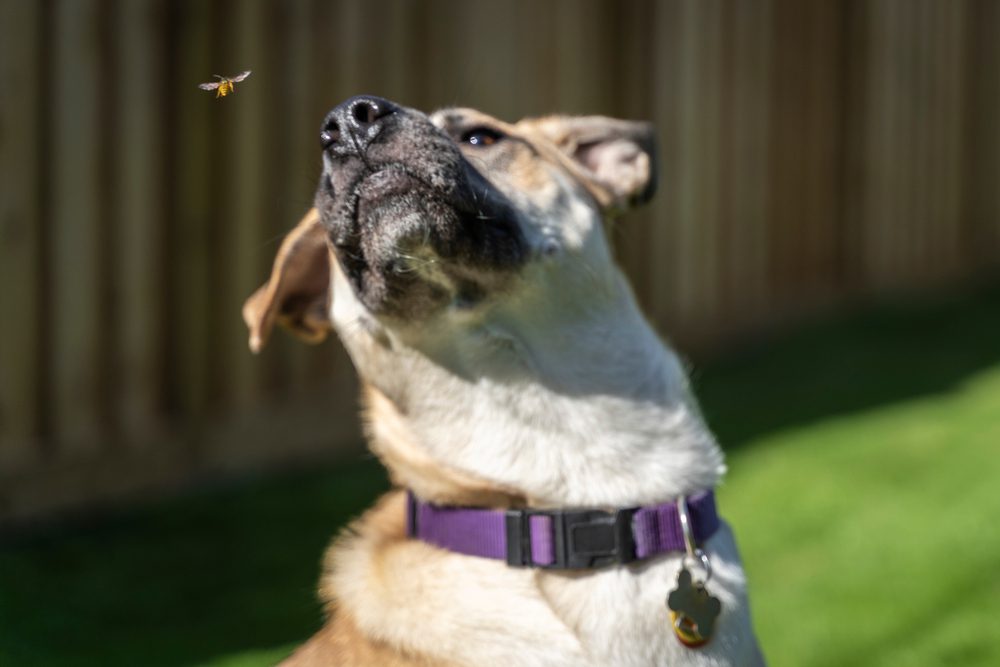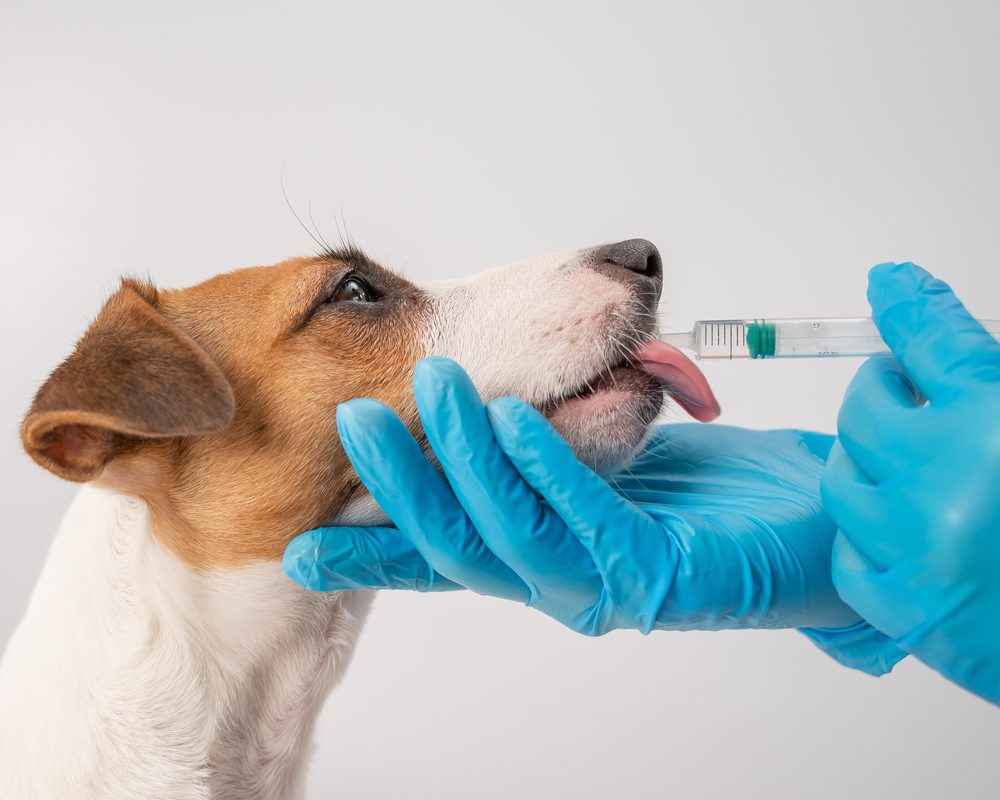A Complete Guide to Dog Allergies: Causes, Treatments and More!

Table of Contents
Dog allergies–like allergies in humans and other animals–occur when the immune system overreacts to a perceived threat from an outside source. Although increasingly common, it can be difficult to diagnose and treat. Read on to learn more about the causes, symptoms, and management of allergies in dogs.
What are Allergies In Dogs?

Dogs–like all other animals–have a complex immune system to keep their bodies healthy, balanced, and free of disease. However, when this immune system goes wrong, an allergic reaction can occur.
Viruses or allergen particles can enter the body through various pathways. This can include inhalation, consumption, through the skin, or mucous areas such as the eyes or nose.
In response, the body produces white blood cells and antibodies to eliminate the pathogens.
However, this reaction can sometimes get out of control when the body encounters particles that aren’t actually harmful. Particles such as pollen, dust, or certain foods can trigger an allergic reaction in the immune system and are known as allergens or antigens.
The 4 Types Of Dog Allergies You Need To Know About!
A dog allergy can take a number of different forms, depending on the breed of dog, the allergens in question, and how and where it is encountered. Generally, allergic reactions will fit into one of the following categories:
Allergies Caused By Fleas and Parasites
Almost every dog will get fleas, ticks, mites, or other parasites at some point in its life. Usually, these parasites are easily removed, and the dog will not have an adverse reaction. However, some pets will develop allergies, mainly relating to biting parasites. It is typically the parasite’s saliva that causes the allergic reaction in dogs.
Flea bite hypersensitivity will cause extreme dog itching and discomfort to your pet, this is known as flea bite dermatitis or pruritus. Symptoms and signs include:
- excessive scratching
- excessive licking
- hair loss (especially around the rump and hind legs)
- formation of scabs or lesions on the skin.
Symptoms are episodic and tend to worsen in the summer months, as well as when the pet ages.
Diagnosis of a parasite or flea allergy is relatively straightforward, as you or your veterinarian will be able to identify the parasites on the dog’s skin.
Treating the allergic reaction usually involves removing the parasite, either with a topical medicine or by grooming. This should stop the reaction.
For excessive itching, vets may prescribe steroids (corticosteroids), antihistamines, or antibiotics for a secondary infection.
Dog Allergies Caused By Food
Dogs can develop a food allergy or food hypersensitivity at any age, and to any carbohydrate or protein component of their food. Antihistamines and steroids are usually not effective in treating a food allergy in dogs.
Instead, to identify and treat food allergies in dogs, most veterinarians recommend an elimination diet that will cut out specific ingredients, one at a time.
Once you identify the allergen, you can then eliminate that specific component from your dog’s diet for good.
Your vet will advise you on the best way to carry out this diet. It is essential that you stick to the diet all the way through, even if your dog’s symptoms subside. Treats and supplements are also components of the exclusion diet.
Contact Allergies
A contact allergy is caused by the dog’s skin coming into contact with a specific substance or material, such as shampoo, flea treatments, or wool bedding. This type of allergy is usually manifested on the dog’s skin in the form of itching and dermatitis.
The allergic reaction will be localized to the area that came into contact with the allergen. Contact allergies are the least common form of dog allergies, but can still be very uncomfortable for your pet.
Environmental Allergies
An environmental allergy, seasonal allergy, or inhalant allergy is caused by allergens in the air that your pet breathes in. This is also known as atopy.
Allergies of this kind are often seasonal, relating to specific plants that only grow at certain times of the year. However, environmental allergies in dogs can occur year-round too, in response to allergens such as grass, mold, and mildew.
- Formulated to deliver digestive support, promote healthy yeast production, and encourage a normal immune response.
- Contains healthy ingredients and 8 strains of beneficial bacteria that work as a digestive aid, optimize skin health, and support coat comfort.
- Easy to use on either young puppies or senior dogs.
Dog Parasites—Itchy Dog And Creepy Fleas
Are you ready for your skin to crawl?
Some of the most common dog allergies are caused by tiny parasites that are found just about anywhere that dogs are. Read on to learn more about the creepy crawlies that are making your dog—and you—itch.
Types of Parasites That Cause Dog Allergies!

The following parasites are the most frequently found:
Mites
Mites are tiny arthropods. Despite their small size, they can cause huge problems for a man’s best friend. The most common kind of mites that cause allergies in dogs is house dust mites. These feed off dead hair and skin, living in carpets, upholstery, and bedding.
Dogs are not allergic to the mites themselves, but a protein found in the mites’ feces.
Ticks
Ticks are small arachnids, which feed on the blood of mammals. They attach themselves to the animal’s skin and bury their head beneath the surface.
These bloodsuckers are usually found in the wilderness and wooded areas. They transfer onto a pet as it brushes against the grass or tree where the tick is hiding. It is the tick’s saliva that causes an allergy in dogs.
As well as causing an allergic reaction, ticks can also spread other diseases in dogs and humans. They can even cause anemia in the case of a severe infestation.
You should check your dog for ticks frequently, and remove them using a special tool (do not pull them out or try to burn them off).
Fleas
Fleas are small insects that cannot fly, though they can jump many times their body height. Like ticks, fleas feed off your dog’s blood, and it is their saliva that causes dogs to itch.
Fleas are the most common biting parasite for dogs. Chances are that your pet will get fleas at least once in its lifetime.
Frequent dog flea treatment can keep them at bay, and this is especially crucial in hot climates. While every dog will scratch when bitten by fleas, dogs with a flea allergy will scratch excessively, to the point of hair loss or cause skin lesions.
Flea bite allergies are often seen on the hind legs, tail, and rump of the dog.
Skin Parasites Like Mites Cause Scabies
Scabies or sarcoptic mange is a serious skin condition that can affect dogs of any age and breed. The culprit is a tiny mite called the Sarcoptes scabies mite. This is a skin parasite that is extremely contagious.
These mites will burrow under the dog’s skin, which can lead to extreme itching, hair loss, and scabbing.
Dog Skin Allergies: From Ringworm In Dogs To Canine Atopic Dermatitis
The majority of allergies in dogs manifest on the skin, whether or not the allergen has come into direct contact with the skin. This can make it tricky to diagnose the cause of the dog’s skin allergy.
It is important to pay close attention to the allergic reaction, especially when and where it occurs.
What Is Canine Atopic Dermatitis?
Atopic dermatitis is a chronic skin condition associated with allergies in dogs. It can either be the result of an allergic reaction, or due to coming into contact with an irritant, such as a chemical, or a certain plant or animal.
Canine atopic dermatitis usually appears in younger dogs, between the ages of 3 months and 6 years. It may, however, take some time to diagnose, and can worsen with age.
Symptoms include:
- excessive scratching
- excessive licking
- excessive chewing
- skin inflammation
- rashes
- sneezing
Atopic dermatitis typically affects areas where the skin is thinner or more sensitive, such as the ears, around the eyes, underarms, groin, muzzle, and between the toes.
What is Ringworm In Dogs?
Despite the name, ringworm isn’t actually caused by worms, but rather by a fungal infection. Ringworm is contagious to humans and can be transferred from dogs to humans and other animals.
The symptoms of ringworm in dogs are itching and patches of hair loss, usually located on the head, ears, and forelegs. This helps to differentiate it from a flea bite allergy.
Hot Spots on Dogs
Hot spots in dogs, also called acute moist dermatitis, are moist, red, irritated skin lesions. The most common locations of hotspots on dogs are on the head, chest, and hips.
Dogs will often lick or chew on the affected area, causing the hotspot to grow quickly. Although dogs with longer coats are more likely to develop hotspots, any dog with allergies can develop these painful sores.
Dog Food Allergies—From Chicken To Grains

Just like people can be sensitive or allergic to certain foods, so can dogs. Food allergies in dogs can manifest in a number of ways, not just through an upset stomach.
Skin problems and breathing problems can also indicate a dog food allergy, as can a ear infection. Scooting can also often be a sign of a food allergy in dogs.
Dog Grain Allergy
Most dog foods contain a combination of proteins—usually meats—and carbohydrates, which are often in the form of grains such as barley, corn, rice, and oats. These can often cause allergic reactions in dogs.
Dog Food Allergies—Common Foods A Dog Can Be Allergic To!
The most common foods for dogs to be allergic to are dairy, beef, eggs, wheat, lamb, chicken, pork, soy, fish, and rabbit.
Contact Allergies In Dogs—Contact Allergies Can Cause Dog Skin Problems
Contact allergies in dogs are treated by removing the allergen, and in extreme cases with antihistamines or steroids to treat the symptoms. It can sometimes be challenging to identify the allergen, especially if your dog develops an allergy to a product that you have been using for some time.
Try keeping a record of every substance that you are putting on your dog, and cross-referencing when the allergic reaction occurs. This can help you to identify the allergen and then remove it.
Can Dogs Be Allergic To Cats?
It is a well-known fact that some people are allergic to dog dander or cat dander, which is composed of tiny particles of shed hair and skin.
What is less well known is that dogs can also be allergic to cats—and to people! Symptoms of a cat allergy in dogs are usually inflamed or itchy skin, sneezing, or a runny nose.
Veterinarians can test for an allergy to cat dander, and treat it in the same way they treat other environmental allergies.
Environmental Allergies—Another Common Dog Allergy
Environmental allergies in dogs are very common and can be difficult to manage if the allergen is something that is very prevalent in the environment, such as pollen.
Some owners swear by bathing their dogs more frequently during allergy season to remove allergens from the coat. Others install air purifiers in their houses to remove particles.
Dogs with environmental allergies may respond well to hyposensitization, as this can be easier than trying to remove contact with the allergen.
From Swollen Faces To A Broken Bark: A Dog Stung By Bee!

Some dogs love to chase and snap at bugs and bees—but what happens when the bee fights back?
Bee Sting Reactions!
When a dog is not allergic to bee stings, their reaction will probably not be serious and limited to slight swelling in the immediate area and some tenderness. You should always remove the stinger with a pair of tweezers, and disinfect the area.
If your dog is allergic to bee stings, however, their reaction could be a lot more serious. Allergic reactions will show up immediately!
In extreme cases, bee sting allergies in dogs can cause the animal to go into anaphylactic shock. The symptoms of anaphylactic shock are:
- trouble breathing
- wheezing
- a bluish tint to the skin
- collapse
If your dog displays any signs of an allergic reaction following a bee sting, take them to an emergency veterinarian immediately.
Baby Benadryl—An Easy Way To Treat A Dog Bee Sting!
Benadryl for dogs? Baby Benadryl (generic name: diphenhydramine) is a milder form of the popular over-the-counter antihistamine medication, and many vets recommend it for a dog with allergies, or when a bee stings a dog.
Usually, the recommended dosage for dogs is 1mg per pound of body weight, 2 to 3 times daily. Baby Benadryl is 12.5mg per chewable tablet, so for a 25-pound dog, two tablets would be enough. Always consult a veterinarian before giving your dog Benadryl or any other medication.
Dog Allergic Reaction? Here are The Symptoms!
Treating or managing a dog’s allergy begins by identifying the symptoms. Sometimes these symptoms are very obvious, and sometimes they are more subtle.
Dog Food Allergy Symptoms
The symptoms of a food allergy in dogs can include:
- loss of appetite
- vomiting
- diarrhea
- allergy dermatitis
- itching
Occasionally asthma or breathing difficulties may be associated with dog food allergies. Due to the wide range of symptoms that can indicate a food intolerance, allergy, or sensitivity, they can be difficult to diagnose.
This process should be left to a veterinarian. The symptoms of food allergies can also indicate other diseases or conditions, so make sure to rule out other causes.
Diagnosing Allergies In Dogs! From Dog Allergy Testing And More!
Diagnosing dog allergies can be very tricky, and should always be done in consultation with your veterinarian. The type of allergy testing used to find the allergen depends on the type of allergic reaction, and the suspected allergen.
This can differ greatly depending on the lifestyle, breed, and age of the dog.
Blood tests and pin-prick tests are used to narrow down potential environmental allergens, while parasitic allergens are usually easily identified on the dog’s coat.
Food allergies should always be tested using an exclusion diet, as no other method has proven reliable.
Treatment For Dog Allergies!

Dog allergies and allergies, in general, are usually not treatable in themselves. You need to treat the symptoms and remove the allergen wherever possible.
There are a number of different treatments for the symptoms of allergies.
Which treatment you choose depends on many factors, including the type of allergy, which symptoms are present, the size and age of your dog, your budget, and many more.
Zyrtec For Dogs AKA Antihistamines for Dogs
For many years, Benadryl was the antihistamine of choice for dogs. While it is safe, it can make dogs drowsy, and it must be given 2-3 times a day. Zyrtec (generic name: Cetirizine) is now a more popular choice of antihistamine as it is less likely to make dogs drowsy. Zyrtec for dogs can be given just once a day.
Allergy Medicine for Dogs
Other allergy medications for dogs include Chlortrimeton (generic name: Chlorpheniramine) and Atarax (generic name: Hydroxyzine), both of which are antihistamines.
Another popular way to treat dog allergies is to give supplements of EPA (eicosapentaenoic acid), which is an Omega-3 Fatty Acid and can work in synergy with an antihistamine to reduce allergic reaction symptoms in dogs.
Atopica for dogs is definitely well worth asking your vet about!
It takes on the most chronic of allergies!
Essential Oils For Dogs
Essential oils are plant-based extracts that are used as holistic medicines. Although they are not scientifically proven to help, many people swear by using essential oils to alleviate their dogs’ allergies.
Basil, ginger, and rosemary are used as anti-inflammatories! Lemongrass, citronella, and rosemary can help with keeping insects away.
Thyme, lemon, and peppermint can ease respiratory symptoms. Peppermint, chamomile, and lavender can soothe skin reactions. Only use diluted, therapy-grade essential oils for dogs.
Warning!
Some essential oils are dangerous to dogs, and should always be avoided. These include tea trees, camphor, and pennyroyal. Always check whether an essential oil is poisonous to dogs before commencing treatment.
Hyposensitization
Hyposensitization, also known as allergen immunotherapy, desensitization, or “allergy shots” is a treatment used to combat allergies in dogs, as well as other pets and people.
The process involves building up the dog’s resistance to the allergen by introducing small amounts of the substance. You then gradually increase the amounts until the dog is no longer allergic.
Hyposensitization is one of the only ways of stopping an allergy, rather than simply stopping exposure to the allergen or treating the allergy’s symptoms.
You should only begin the hyposensitization treatment after discussing it with your veterinarian, as introducing allergens to your dog in an unmanaged way could lead to a severe reaction.
Anti-Inflammatory!
If your dog’s allergic reaction involves inflammation of any kind, your veterinarian may prescribe anti-inflammatory drugs. The side effects of Non-Steroidal Anti Inflammatory Drugs (NSAIDs) are less severe than steroids.
Popular NSAIDs for treating dog allergies are Rimadyl, also known as Novox or carprofen, Metacam or meloxicam, and even types of aspirin.
Always get a prescription from your veterinarian before starting your dog on any medication.
Natural anti-inflammatory treatments, though unproven, are very popular with owners of allergic dogs. Ginkgo, turmeric, fish oil, ginger, and vitamin C all have anti-inflammatory properties, though you should still consult with your vet before incorporating them into your dog’s diet, especially if your dog is suffering from a food allergy.
Home Remedies for Dog Allergies Start With Change!

If your dog suffers from allergies, your first port of call should always be to eliminate the allergens as much as possible. This could mean keeping an extra clean house to avoid house dust mites or switching to a hypoallergenic dog food diet.
Sometimes relatively small lifestyle changes can make a big difference to you and your dog.
For Fleas Consider A Dog Flea Allergy Treatment
Keeping your dog free of fleas and other pests can make a huge difference to your dog’s quality of life, and your own. Spot-on treatments can help keep fleas at bay, and to kill any fleas currently on your dog, or there are pills available that you can give to your dog to kill any fleas living on it.
There are also a number of soothing flea shampoo for dogs available that will remove fleas and soothe the skin all in one go.
Look For The Best Dog Food For Allergies
Although all dogs are different, there are certain foods that are typically less likely to cause an allergic reaction in dogs.
These foods include venison, potato, kangaroo, and gluten-free oatmeal. Consult with your vet before dramatically altering your dog’s diet.
Baby Benadryl For Those Bee Sting Reactions!
As discussed above, keeping an over-the-counter medication such as Benadryl in the house can help to ease the symptoms of an allergy sufferer in a pinch, especially if you live far from the vet. Though it may not replace other treatments, it can certainly help to alleviate the worst of a reaction.
5 Facts You Need To Know About Allergies In Dogs!
- 20 to 25% of dogs suffer from allergies at some point in their lives.
- Of these dogs, just 10 to 15% of dog allergies are related to food, while the vast majority of dog allergies are caused by environmental, non-food allergies.
- Dogs with allergies can still live healthy, happy lives, and treatment options are always evolving.
- Dogs can, and often do, have multiple allergies, often of different kinds. Your pooch may be allergic to grass particles, for example, but also to gluten in their food. This only adds to the complexity of diagnosis.
- Some people believe that dog allergies are becoming more common due to the increasing prevalence of synthetic chemicals around the home and in food. These can affect the dog’s natural balance and lead to allergic reactions.
Dog allergies can be very distressing for dogs and owners alike. With proper management, however, allergies don’t need to stop your pup from leading a full, happy, and healthy life.

















